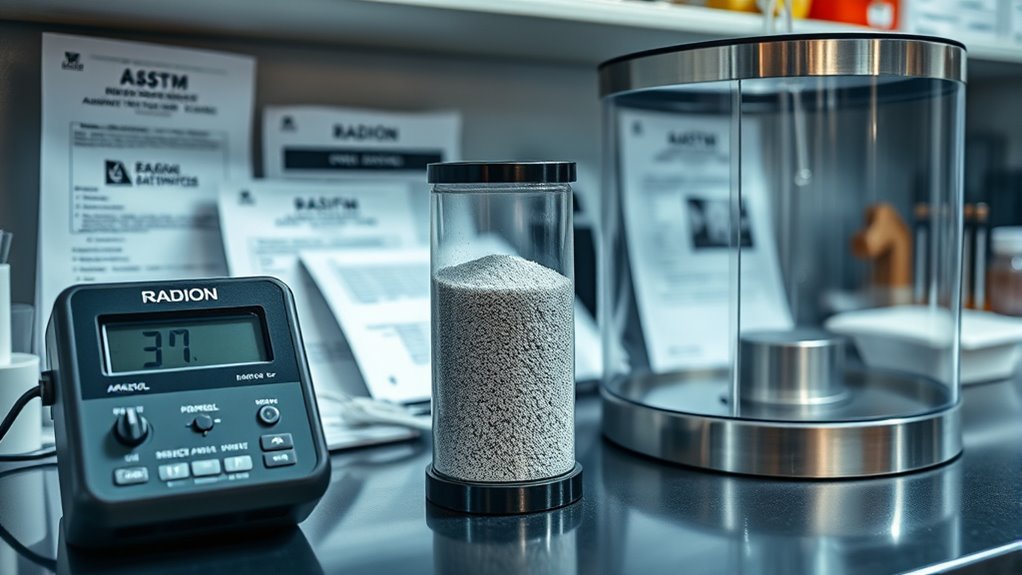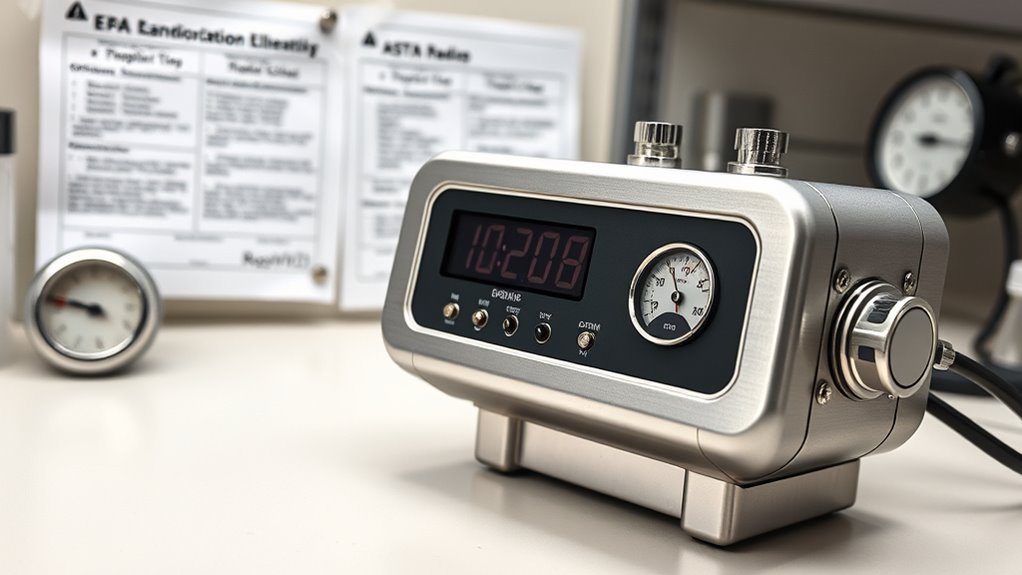Radon measurement standards from ASTM and the EPA provide clear guidelines to guarantee your tests are accurate and reliable. They specify proper device types, placement practices, and test durations to help you avoid common mistakes like poor placement or incorrect timing. Following these protocols helps you get consistent results and makes interpreting radon levels easier for decision-making. Keep going, and you’ll gain a deeper understanding of how these standards protect your measurements.
Key Takeaways
- ASTM standards specify device types, placement criteria, and test durations to ensure consistent and accurate radon measurements.
- EPA guidelines recommend short-term and long-term testing methods, emphasizing detector placement and calibration for reliable results.
- Both protocols highlight avoiding drafts, sunlight, and interference during device placement to improve data accuracy.
- ASTM and EPA standards include quality assurance measures to mitigate errors and ensure measurement integrity.
- Proper adherence to these standards enhances confidence in radon level assessments and mitigation decisions.

Radon measurement standards guarantee that testing methods produce accurate and consistent results across different settings. When you’re conducting radon testing, understanding the established protocols is vital to guarantee your measurements are reliable. Both ASTM and EPA protocols set clear guidelines designed to standardize radon testing techniques, which directly influence measurement accuracy. These standards help you avoid common pitfalls, such as improper device placement or incorrect test durations, that could skew your results. By adhering to these guidelines, you can confidently interpret your radon levels and make informed decisions about necessary mitigation actions.
The ASTM (American Society for Testing and Materials) provides extensive standards that specify how to perform radon testing in residential and commercial environments. These standards detail the types of devices you should use, how to position them, and the duration of testing periods. For example, ASTM standards emphasize using certified continuous radon monitors or charcoal test kits, depending on your specific needs. They also specify placement criteria—such as avoiding drafts or direct sunlight—that help guarantee the measurement captures the typical radon levels you’d encounter in day-to-day living. Following ASTM protocols not only improves measurement accuracy but also facilitates consistency across different testing sessions and locations. This consistency is vital if you’re comparing results over time or between different properties.
The EPA’s radon testing protocols focus on short-term and long-term testing methods, providing step-by-step procedures to enhance measurement accuracy. The EPA recommends using charcoal canisters, alpha track detectors, or continuous radon monitors, each suited for different testing durations and circumstances. Their guidelines specify how long tests should run—typically 2 to 7 days for short-term tests—and stress the importance of placing detectors in the lowest livable area, away from windows, doors, or other sources of interference. The EPA also emphasizes following proper calibration and quality assurance measures, guaranteeing your testing results truly reflect the radon levels in your environment. These protocols help you avoid errors that can lead to underestimating or overestimating radon concentrations.
Additionally, understanding the impact of a cybersecurity incident like a system outage on radon testing devices and data integrity is crucial for ensuring reliability and safety.
Frequently Asked Questions
How Often Should Radon Testing Be Repeated for Accuracy?
You should repeat radon testing every two years for accuracy verification, especially if previous tests showed elevated levels or if there have been significant changes in your home’s structure. Regular testing guarantees reliable results and helps you determine if mitigation measures are necessary. Keep in mind that testing frequency can vary based on your local environment and any recent renovations. Staying proactive with testing maintains a safe indoor environment.
What Are the Latest Updates to EPA Radon Standards?
The EPA recently updated its radon standards, emphasizing improved testing equipment accuracy and radon mitigation techniques. You should guarantee your testing devices meet current EPA guidelines for reliable results. If radon levels are high, consider radon mitigation strategies to reduce indoor exposure. Regular testing with certified equipment helps maintain safety and compliance, especially after any home renovations or if you’ve experienced changes in radon levels.
How Do Different Measurement Devices Compare in Reliability?
Imagine holding a device that captures hidden threats in your home’s air. You’ll find that charcoal canisters often provide quick readings but may lack consistency, while continuous monitors excel in measurement consistency and accuracy over time. Electronic devices tend to be more reliable, giving you peace of mind with precise readings. Your choice depends on balancing accuracy and consistency, ensuring you keep radon levels in check effectively.
Are There Regional Variations in Radon Testing Protocols?
You’ll find regional differences in radon testing protocols, as states or local agencies may adopt specific guidelines based on local conditions or regulations. These variations can affect testing methods, device placement, and reporting requirements. It’s important to familiarize yourself with your area’s specific testing protocols to guarantee accurate results. By understanding these regional differences, you can better interpret testing outcomes and take appropriate mitigation steps if needed.
What Are Common Mistakes to Avoid During Radon Testing?
You don’t want to jeopardize your radon test, so avoid common mistakes like neglecting proper measurement calibration and using faulty testing equipment. If you skip calibration, your results could be misleading, putting you at risk. Always make certain your devices are correctly calibrated and functioning. Don’t rush the process or move the testing devices unnecessarily—these errors could hide the true radon levels and lead to dangerous misconceptions.
Conclusion
By understanding ASTM and EPA radon measurement standards, you guarantee accurate, reliable results for safety. Following these protocols helps you identify potential risks and protect your loved ones effectively. Are you ready to prioritize your health by adhering to trusted testing methods? Remember, proper measurement isn’t just a formality—it’s your first step toward a safer, healthier environment. Don’t leave your safety to chance—use these standards as your guide.










